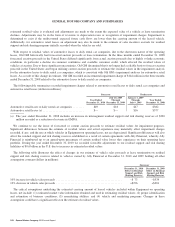General Motors 2010 Annual Report Download - page 114
Download and view the complete annual report
Please find page 114 of the 2010 General Motors annual report below. You can navigate through the pages in the report by either clicking on the pages listed below, or by using the keyword search tool below to find specific information within the annual report.GENERAL MOTORS COMPANY AND SUBSIDIARIES
We are exposed to credit risk related to the potential inability to access liquidity in money market funds we invested in if the funds
were to deny redemption requests. As part of our risk management process, we invest in large funds that are managed by reputable
financial institutions. We also follow investment guidelines to limit our exposure to individual funds and financial institutions.
Automotive Financing
Fluctuations in market interest rates affect GM Financial’s credit facilities and securitization transactions. GM Financial’s gross
interest rate spread, which is the difference between interest earned on finance receivables and interest paid, is affected by changes in
interest rates as a result of GM Financial’s dependence upon the issuance of variable rate securities and the incurrence of variable rate
debt to fund purchases of finance receivables.
Credit Facilities
Fixed interest rate receivables purchased by GM Financial are pledged to secure borrowings under its credit facilities. Amounts
borrowed under these credit facilities bear interest at variable rates that are subject to frequent adjustments to reflect prevailing market
interest rates. To protect the interest rate spread within each credit facility, GM Financial is contractually required to enter into interest
rate cap agreements in connection with borrowings under its credit facilities. The purchaser of the interest rate cap pays a premium in
return for the right to receive the difference in the interest cost at any time a specified index of market interest rates rises above the
stipulated cap rate. The purchaser of the interest rate cap bears no obligation or liability if interest rates fall below the cap rate. As part
of GM Financial’s interest rate risk management strategy and when economically feasible, it may simultaneously enter into a
corresponding interest rate cap agreement in order to offset the premium paid by the trust to purchase the interest rate cap and thus
retain the interest rate risk. The fair value of the interest rate cap purchased is included in Total GM Financial Assets and the fair
value of the interest rate cap agreement sold is included in Total GM Financial Liabilities.
Securitizations
The interest rate demanded by investors in GM Financial’s securitization transactions depends on prevailing market interest rates
for comparable transactions and the general interest rate environment. GM Financial utilizes several strategies to minimize the effect
of interest rate fluctuations on its gross interest rate margin, including the use of derivative financial instruments and the regular sale
or pledging of automotive receivables to securitization trusts.
In GM Financial’s securitization transactions, it transfers fixed rate finance receivables to securitization trusts that, in turn, sell
either fixed rate or floating rate securities to investors. The fixed rates on securities issued by the trusts are indexed to market interest
rate swap spreads for transactions of similar duration or various LIBOR rates and do not fluctuate during the term of the
securitization. The floating rates on securities issued by the trusts are indexed to LIBOR and fluctuate periodically based on
movements in LIBOR. Derivative financial instruments, such as interest rate swap and cap derivatives, are used to manage the gross
interest rate spread on these transactions. GM Financial uses interest rate swap derivatives to convert the variable rate exposures on
securities issued by its securitization trusts to a fixed rate, thereby locking in the gross interest rate spread to be earned by it over the
life of a securitization. Interest rate swap derivatives purchased by GM Financial do not affect the amount of cash flows received by
holders of the asset-backed securities issued by the trusts. The interest rate swap derivative serve to offset the effect of increased or
decreased interest paid by the trusts on floating rate asset-backed securities on the cash flows received from the trusts. GM Financial
utilizes such arrangements to modify its net interest sensitivity to levels deemed appropriate based on risk tolerance. In circumstances
where the interest rate risk is deemed to be tolerable, usually if the risk is less than one year in term at inception, GM Financial may
choose not to hedge potential fluctuations in cash flows due to changes in interest rates. Its special purpose entities are contractually
required to purchase a derivative financial instrument to protect the net spread in connection with the issuance of floating rate
securities even if GM Financial chooses not to hedge its future cash flows. Although the interest rate cap derivatives are purchased by
the trusts, cash outflows from the trusts ultimately affect GM Financial’s retained interests in the securitization transactions as cash
expended by the securitization trusts will decrease the ultimate amount of cash to be received by GM Financial. Therefore, when
economically feasible, GM Financial may simultaneously sell a corresponding interest rate cap derivative to offset the premium paid
by the trust to purchase the interest rate cap derivative. The fair value of the interest rate cap derivatives purchased in connection with
112 General Motors Company 2010 Annual Report
























